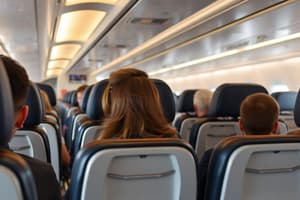Podcast
Questions and Answers
What is the primary role of IATA?
What is the primary role of IATA?
- Conducting independent airline audits.
- Monitoring flight schedules for all airlines.
- Establishing regional airline regulations.
- Serving as a trade association for airlines worldwide. (correct)
Which of the following best describes the focus area of IATA related to enhancing aviation safety?
Which of the following best describes the focus area of IATA related to enhancing aviation safety?
- Improving operational management through global standards. (correct)
- Creating new airline routes to increase traffic.
- Developing environmental sustainability programs.
- Increasing ticket sales for global airlines.
Which statement about IATA membership is accurate?
Which statement about IATA membership is accurate?
- It comprises over 290 airlines, covering approximately 82% of global air traffic. (correct)
- It includes only full members with equal responsibilities.
- More than 400 airlines are represented in its membership.
- Membership is limited to only national carriers.
What is the objective of the IATA Dangerous Goods Regulations?
What is the objective of the IATA Dangerous Goods Regulations?
What does the IATA Travel Pass offer to travelers?
What does the IATA Travel Pass offer to travelers?
Which of the following is NOT a key area of focus for IATA?
Which of the following is NOT a key area of focus for IATA?
Which initiative assesses airline operational management and control systems?
Which initiative assesses airline operational management and control systems?
What unique codes does IATA assign to identify airlines and airports?
What unique codes does IATA assign to identify airlines and airports?
Flashcards
IATA
IATA
The International Air Transport Association, a global trade group for airlines.
IATA's Purpose
IATA's Purpose
To promote safe, regular, and economical air travel on a global scale.
IATA Standards
IATA Standards
Global standards for airline safety, security, efficiency, and sustainability.
IATA Membership
IATA Membership
Signup and view all the flashcards
IOSA
IOSA
Signup and view all the flashcards
IATA Travel Pass
IATA Travel Pass
Signup and view all the flashcards
IATA Codes
IATA Codes
Signup and view all the flashcards
Interline Agreements
Interline Agreements
Signup and view all the flashcards
Study Notes
IATA Overview
- IATA: International Air Transport Association.
- Founded: April 19, 1945, in Havana, Cuba.
- Headquarters: Montreal, Canada.
Purpose and Functions
- Serves as a trade association for airlines worldwide.
- Aims to promote safe, regular, and economical air transport.
- Develops global standards for airline safety, security, efficiency, and sustainability.
- Provides training and consulting services for aviation professionals.
Membership
- Comprises over 290 airlines, representing approximately 82% of global air traffic.
- Membership includes both full and associate members, with varying benefits and responsibilities.
Key Areas of Focus
- Safety: Enhances aviation safety through global standards and collaborative initiatives.
- Economic Policy: Advocates for policies that foster economic growth in aviation.
- Environment: Promotes sustainable practices to reduce the aviation industry's environmental impact.
- Passenger Services: Implements initiatives to improve passenger experience and efficiency.
Important Programs and Initiatives
- IATA Operational Safety Audit (IOSA): A program that assesses airline operational management and control systems.
- IATA Travel Pass: A digital platform for travelers to manage their health credentials.
- Global Distribution System (GDS): Streamlines booking processes and information sharing among airlines and travel agents.
Key Terms and Concepts
- IATA codes: Unique three-letter codes assigned to airlines and airports for identification.
- IATA Billing and Settlement Plan (BSP): Simplifies the selling, reporting, and remitting procedures of travel agents.
- Interline Agreements: Arrangements between airlines to allow passengers to travel on multiple airlines with a single ticket.
Industry Standards
- IATA Dangerous Goods Regulations (DGR): Guidelines for the safe transport of hazardous materials in air cargo.
- IATA Passenger Service Conference Resolutions: Standards for ticketing, fare construction, and passenger service practices.
Publications
- IATA Annual Report: Overview of the association’s activities and financial performance.
- IATA World Air Transport Statistics: Comprehensive statistics on the airline industry.
Events
- Hosts various conferences and exhibitions globally to discuss trends and advancements in air transport.
IATA Overview
- IATA stands for International Air Transport Association, founded on April 19, 1945, in Havana, Cuba.
- The headquarters is located in Montreal, Canada.
Purpose and Functions
- Functions as a global trade association representing airlines.
- Promotes safe, regular, and economical air transport.
- Establishes global standards for safety, security, efficiency, and sustainability in the aviation sector.
- Offers training and consulting services to aviation professionals.
Membership
- Includes over 290 member airlines, representing approximately 82% of global air traffic.
- Membership is categorized into full and associate members, each with distinct benefits and responsibilities.
Key Areas of Focus
- Safety: Focuses on enhancing aviation safety through the establishment of global standards and collaborative initiatives.
- Economic Policy: Advocates for policies that contribute to aviation economic growth.
- Environment: Promotes sustainable practices aimed at minimizing the environmental impact of the aviation industry.
- Passenger Services: Implements initiatives designed to enhance the passenger experience and improve operational efficiency.
Important Programs and Initiatives
- IATA Operational Safety Audit (IOSA): Assesses airline operational management and control systems to ensure safety.
- IATA Travel Pass: A digital tool for travelers to manage health credentials during their journeys.
- Global Distribution System (GDS): Facilitates streamlined booking and information sharing between airlines and travel agents.
Key Terms and Concepts
- IATA codes: Unique three-letter identifiers for airlines and airports to simplify identification.
- IATA Billing and Settlement Plan (BSP): Simplifies the procedures for selling, reporting, and remitting by travel agents.
- Interline Agreements: Facilitate passenger travel on multiple airlines under a single ticket arrangement.
Industry Standards
- IATA Dangerous Goods Regulations (DGR): Guidelines ensure the safe transport of hazardous materials in air cargo.
- IATA Passenger Service Conference Resolutions: Establish standards for ticketing, fare construction, and passenger service practices.
Publications
- IATA Annual Report: Summarizes the association’s activities and financial performance annually.
- IATA World Air Transport Statistics: Provides extensive statistics related to the airline industry.
Events
- Organizes various global conferences and exhibitions to discuss industry trends and advancements in air transport.
Studying That Suits You
Use AI to generate personalized quizzes and flashcards to suit your learning preferences.



